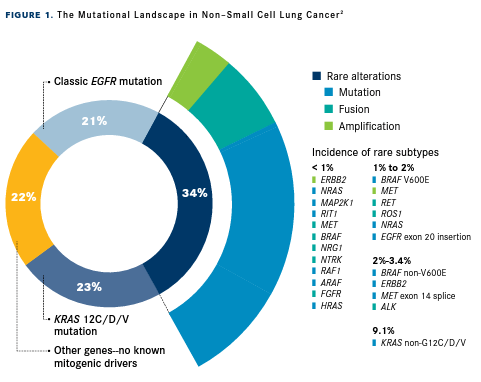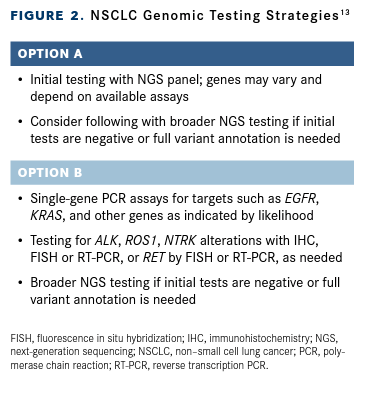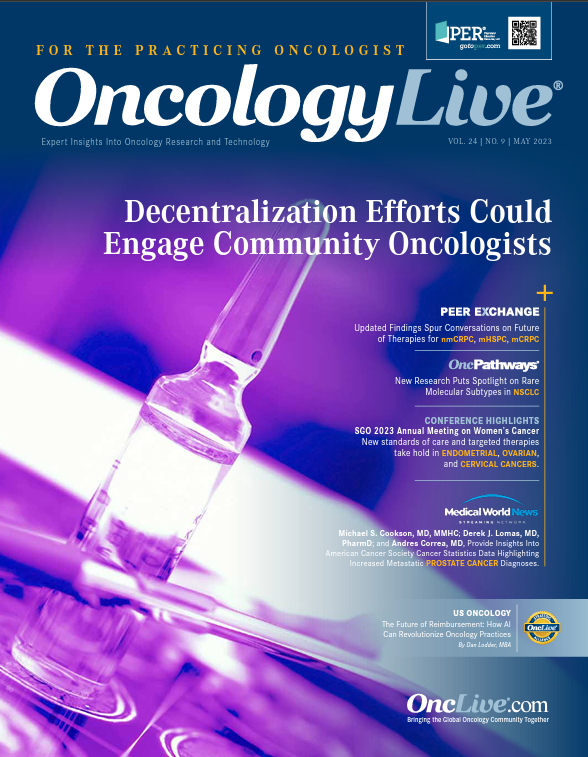Publication
Article
Oncology Live®
New Research Results Spotlight Rare Molecular Subtypes in NSCLC
Author(s):
Although molecularly targeted therapies have transformed the treatment paradigm for NSCLC, the kaleidoscope of genomic alterations that affects subsets of patients is straining the limits of current diagnostic and clinical discovery approaches.
Alexander Drilon, MD

Although molecularly targeted therapies have transformed the treatment paradigm for non–small cell lung cancer (NSCLC),1 the kaleidoscope of genomic alterations that affects subsets of patients is straining the limits of current diagnostic and clinical discovery approaches, experts say. There is a continuing need for novel strategies, including the use of real-world evidence, to advance drug development for patients with less common aberrations.2
Approximately 34% of lung adenocarcinomas, the largest subtype of NSCLC,3 harbor a rare oncogenic driver alteration, according to findings from a recent analysis published in Nature Reviews Clinical Oncology. These alterations include commonly recognized subtypes such as tumors with mutations in EGFR exon 20, BRAF V600E, ERBB2, and MET, and those with fusions in ALK, ROS1, RET, and NTRK1/2/3. The second group involves less-common subtypes, such as those with mutations in HRAS, NRAS, DDR2, LTK, RIT1, and ARAF, among other genes.2
In NSCLC, a molecular subtype generally is characterized in research reports as rare if aberrations are detected in 5% or less of tumor samples. However, investigators noted that NSCLCs with rare subtypes affect approximately 10,000 patients in the United States annually and nearly 94,000 worldwide.2
In the United States, the frequency of some rare NSCLC subtypes is comparable to or greater than the number of patients diagnosed annually with other rare cancers. For example, more patients receive a diagnosis of NSCLC with MET splice aberrations or ALK fusions than acute lymphocytic leukemia, vulvar cancer, bone cancer, and penile and other male genital malignancies.2
In addition to characterizing rare NSCLC molecular subtypes, investigators also discussed the challenges of developing therapies that may be effective against these aberrations. “Oncogenedriven advocacy, the adoption of contemporary trial designs, expedited regulatory pathways for drug development, and real-world evidence generation are all crucial steps toward promoting research and expediting the approval of drugs for rare oncogene-driven lung cancers,” they said.2
The analysis was conducted by investigators from Memorial Sloan Kettering (MSK) Cancer Center in New York, New York, and Sylvester Comprehensive Cancer Center at the University of Miami at the Miller School of Medicine in Florida.
Alexander Drilon, MD, chief of the Early Drug Development Service at MSK, helped supervise the work. Drilon and colleagues at MSK have been instrumental in clinical studies that paved the way for FDA approvals of new drugs to treat patients with NTRK1/2/3 fusions and RET alterations, both rare genomic aberrations.
Drilon was a principal investigator on a series of clinical studies that led to the FDA’s accelerated approval of larotrectinib (Vitrakvi), the first inhibitor of TRK proteins, which are encoded by an NTRK gene, in November 2018. The approval encompasses adult and pediatric patients with NTRK fusion–positive solid tumors that are metastatic or for which surgical resection is likely to cause severe morbidity. The FDA hailed the approval, based on tumor genetics rather than histology, as an example of an emerging paradigm for “tissue-agnostic” drug development.4-6
Additionally, Drilon was a leading investigator for the phase 1/2 LIBRETTO-001 trial (NCT03157128), a multicohort study that led to the accelerated approval of selpercatinib (Retevmo), the first RET-targeting therapy, in May 2020.7 Selpercatinib initially was approved for patients with metastatic RET fusion–positive NSCLC, advanced or metastatic RET-mutated medullary thyroid cancer, and advanced or metastatic RET fusion–positive thyroid cancer refractory to radioactive iodine. The FDA has since granted a regular approval to selpercatinib for the NSCLC indication, while adding an accelerated, tissue-agnostic approval for use of the drug in adults with locally advanced or metastatic solid tumors with RET fusions that progress after prior therapy and do not have satisfactory treatment alternatives.8-10
In their article on rare NSCLC subtypes, Drilon and colleagues noted that a series of strategies already taking shape would have to continue to make progress against rare subtypes. These include increased awareness and advocacy efforts among patients through groups such as the BRAF Bombers, the KRAS Kickers, and the RET Renegades for patients with BRAF, KRAS, and RET aberrations, respectively.2
Basket trials, in which patients are recruited based on the molecular profile of their tumor rather than the tissue of origin site, have helped promote the development of TRK-targeting therapies, investigators noted. Other innovations include statistical analysis methods used in adaptive trial designs.2
Regulatory mechanisms, such as the FDA’s priority review and accelerated approval programs, have shortened development time for bringing novel therapies from early testing to clinical practice. Of note, fam-trastuzumab deruxtecan-nxki (Enhertu) became the first antibody-drug conjugate granted accelerated approval for a rare oncogene-driven NSCLC subtype in August 2022.2,11 The FDA approved the compound for patients with unresectable or metastatic NSCLC harboring activating ERBB2 mutations (also called HER2 mutations).11
Finally, real-world data gathered globally through research and patient networks can help generate information that can be used comparatively to evaluate therapies directed at rare oncogene-driven NSCLC subtypes, Drilon and colleagues said. They cited examples of registries that already have been formed, such as GLORY for RET fusions and eNRGy1 for NRG1 fusions.2
Diversity of NSCLC Aberrations
In calling for innovation in drug development, investigators describe a constellation of genomic alterations in NSCLC. Lung cancer is characterized by “an incredible diversity of molecular subtypes,” including mutations, fusions, and copy number changes, Drilon and colleagues said.2 They analyzed molecular findings involving more than 16,000 tumor samples derived from several databases to paint a picture of the mutational landscape.2
They detailed 4 major categories of alterations for lung adenocarcinomas (Figure 1).2 At 34%, rare oncogenic driver alterations comprise the largest category, with 22 aberrations identified. Of these, 21 were detected in less than 4% of samples; mutations in KRAS non-G12C/D/V were included with the rare subtypes even though these alterations were found in 9.1% of samples.2
Figure 1. The Mutational Landscape in Non–Small Cell Lung Cancer2

The 2 most frequently detected aberrations in individual genes are KRAS G12C/D/V mutations, identified in 23% of samples, and classic EGFR mutations, found in 21%.2 Classic EGFR aberrations are those found in exon 21 L858R mutations or exon 19 deletions with or without T790M mutations.12 Another 22% of samples had aberrations in other genes that are not actionable or have not yet been defined as oncogenic.2
Challenges of Biomarker Testing
During the past 2 decades, a growing understanding of the molecular underpinnings of NSCLC has made the tumor type a prime example of precision medicine in oncology. The use of targeted therapies in NSCLC has been expanding since the EGFR mutation was discovered in 2004; nearly 2 dozen oncogene-driven therapies are now available for patients with metastatic NSCLC.13
Today, National Comprehensive Cancer Network (NCCN) guidelines endorse testing patients with advanced or metastatic NSCLC tumors for molecular aberrations in 9 genes: EGFR, ALK, KRAS, ROS1, BRAF, NTRK1/2/3, MET exon 14 skipping, RET, and ERBB2.14
The testing is recommended for adenocarcinomas, large cell tumors, and NSCLC not otherwise specified and is suggested as a consideration for squamous cell carcinomas. High-level MET amplification, defined as a copy number greater than 10 on next-generation sequencing (NGS), is described as an emerging biomarker. Additionally, testing for PD-L1 protein expression levels is recommended for all histologic subtypes.14
Despite evidence showing that the use of molecularly targeted therapies improves survival for many patients with NSCLC with matching aberrations, barriers to biomarker testing present challenges to practicing oncologists throughout the world.13 In a global survey of health care professionals, the International Association for the Study of Lung Cancer (IASLC) found 5 factors identified as barriers, regardless of geographic region: cost, tissue quality (sample inadequacy, suboptimal handling), access to testing (single gene vs single broader panel), prolonged turnaround times, and awareness (familiarity with guidelines, difficulty in interpreting results).13
Testing methodologies also add to the complexity of biomarker identification in NSCLC, the IASLC said in an atlas on molecular testing published in February 2023.13 Multiple considerations, such as the availability of funding, tissue, and testing expertise, are involved in decisions on which assays to use in patient evaluations, according to the IASLC. Most guidelines recommend using NGS panel testing that would provide information about a large number of molecular markers but there are differences in assays. The IASLC provides 2 models for testing for the most clinically relevant aberrations (Figure 2).13
The NCCN guidelines panel “strongly advises” broad molecular profiling, defined as testing that queries all 9 recommended genes as well as other potential aberrations, in either a single assay or a combination of a limited number of assays.14 Although a broad-based NGS assay may be more efficient, tests that cover more than 50 genes may not be practical because of current coding thresholds for such services, the panel notes.14
If an oncogenic driver is not identified through broad NGS testing, the NCCN panel recommends that RNA-based NGS, if not already performed, be considered to improve the chances of detecting a fusion event. Additionally, fluorescence in situ hybridization is useful for analyzing copy number, amplification, and gene rearrangements.14
Figure 2. NSCLC Genomic Testing Strategies13

In their analysis, Drilon and colleagues noted that targeted DNA-based NGS, typically used for genotyping lung cancer, varies in specificity for detecting fusions and alternatively spliced transcripts according to the assay used. They found that assays that combined DNA and RNA sequencing detected a greater percentage of ALK, RET, and ROS1 fusions, and MET splice alterations than did tests using only DNA sequencing.2
By comparison, RNA-based technologies are more sensitive for the detection of oncogenic RNA transcripts that lack large intronic sequences and for occult kinase fusions not identified through DNA-based sequencing.2 This method also is able to assess whether certain fusions of unknown significance detected in DNA will produce oncogenic fusions. However, the use of RNA has its own disadvantages. RNA is less stable than DNA, which results in clinical testing failure rates of 10% to 30%, investigators said.2
A consensus on a testing algorithm that integrates these methods has not yet been reached, Drilon and colleagues said. An alternative similar to NCCN and IASLC observations is to use DNA-based NGS as an initial screening tool and then follow up with RNA-based NGS testing for patients without oncogenic drivers and/or fusions or intronic mutations of unknown significance.2
Experts agree that new technologies must be leveraged to take the next steps in genomic testing in NSCLC. “With increasingly comprehensive genomic testing requiring more sophisticated and time-consuming bioinformatics, it is likely that artificial intelligence and machine learning techniques will be increasingly used in clinical genomic diagnostics,” the IASLC noted.13
References
- Rivera-Concepcion J, Uprety D, Adjei AA. Challenges in the use of targeted therapies in non–small cell lung cancer. Cancer Res Treat. 2022;54(2):315-329. doi:10.4143/crt.2022.078
- Harada G, Yang SR, Cocco E, Drilon A. Rare molecular subtypes of lung cancer. Nat Rev Clin Oncol. 2023;20(4):229-249. doi:10.1038/s41571-023-00733-6
- Non-small cell lung cancer treatment (PDQ)-health professional version. National Cancer Institute; 2023. Updated February 17, 2023. Accessed April 14, 2023. bit.ly/41eiuQL
- Targeted therapy larotrectinib shows promise in early trials, regardless of cancer type. National Cancer Institute. March 9, 2018. Accessed April 17, 2023. bit.ly/3mESvCX
- FDA approves larotrectinib for solid tumors with NTRK gene fusions. FDA. Updated December 14, 2018. Accessed April 17, 2023. bit.ly/3A3gBKS
- FDA approves an oncology drug that targets a key genetic driver of cancer, rather than a specific type of tumor. News release. FDA. November 26, 2018. Accessed April 17, 2023. bit.ly/3UQY79V
- FDA approves first therapy for patients with lung and thyroid cancers with a certain genetic mutation or fusion. News release. FDA. May 8, 2020. Accessed April 17, 2023. bit.ly/3MQ6gcL
- FDA approves selpercatinib for lung and thyroid cancers with RET gene mutations or fusions. FDA. Updated May 11, 2020. Accessed April 17, 2023. bit.ly/3KMWEwP
- FDA approves selpercatinib for locally advanced or metastatic RET fusion-positive non-small cell lung cancer. FDA. September 21, 2022. Accessed April 17, 2023. bit.ly/41t8rY0
- FDA approves selpercatinib for locally advanced or metastatic RET fusion-positive solid tumors. FDA. September 21, 2022. Accessed April 17, 2023. bit.ly/3DDpVYe
- FDA grants accelerated approval to fam-trastuzumab deruxtecan-nxki for HER2-mutant non-small cell lung cancer. FDA. Updated August 16, 2022. Accessed April 20, 2023. bit.ly/3hSydmB
- Robichaux JP, Le X, Vijayan RSK, et al. Structure-based classification predicts drug response in EGFR-mutant NSCLC. Nature. 2021;597(7878):732-737. doi:10.1038/s41586-021-03898-1
- Sholl LM, Cooper WA, Kerr KM, Tan DSW, Tsao MS, Yang JCH, eds.IASLC Atlas of Molecular Testing for Targeted Therapy in Lung Cancer. International Association for the Study of Lung Cancer; 2023. Accessed April 13, 2023. bit.ly/3mr1t6N
- NCCN. Clinical Practice Guidelines in Oncology. Non-small cell lung cancer, version 3.2023. Accessed April 21, 2023. bit.ly/40toNyN









